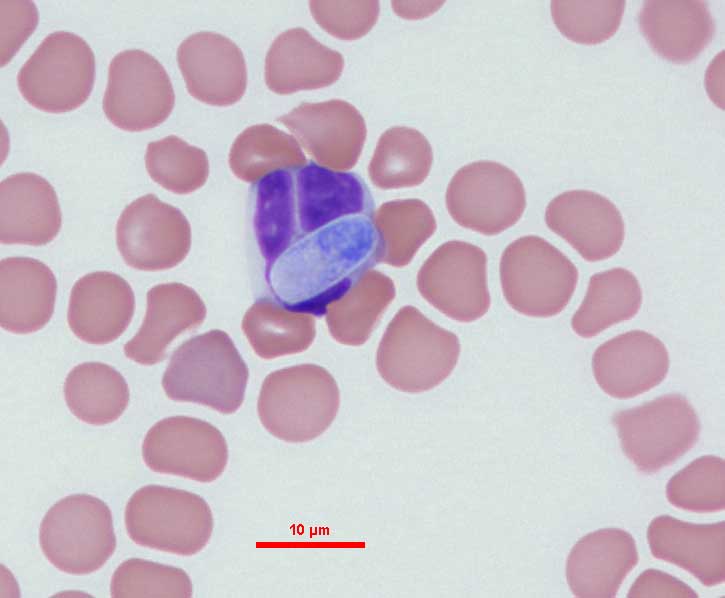Hepatozoon
(Hepatozoon spp.)
Hepatozoon spp. infecting cats are blood apicomplexans that are transmitted through ingestion of an infected tick.
Distribution
Hepatozoon felis has been described and detected from all continents except for Australia [1,2]. There are several genetically-distinct variants of H. felis infecting domestic cats as well as wild felids, wild carnivores and rodents [1,2,3]. Hepatozoon canis infection is more prevalent in domestic dogs and also in foxes than in felids and has been described in cats from Israel, Italy and Spain [2,4,5]. Hepatozoon silvestris has been described in domestic cats from southern Italy and Switzerland, wildcats (F. silvestris silvestris) from Bosnia-Herzegovina, and an Ixodes ricinus tick removed from a domestic cat in the United Kingdom [4,6,7,8].
Clinical signs
Hepatozoon felis causes mostly sub-clinical infection usually with a low parasitaemia in domestic cats and minimal inflammatory responses in the striated muscle tissues where its meronts are found [2]. Some elevation of muscle enzyme activities has been described in cats infected with Hepatozoon spp. [9]. Hepatozoon silvestris has been associated with a fatal myocardial infection in a domestic cat from Switzerland [6]. There are currently no clinical descriptions of H. canis infection in domestic cats.
Diagnosis
Hepatozoonosis can be diagnosed by the detection of Hepatozoon spp. gamonts in leukocytes (Fig. 1) and by the detection of meront stages of Hepatozoon spp. in histopathological specimens of striated skeletal muscles, the myocardium, and occasionally the spleen, lungs, lymph nodes, bone marrow (and other tissue). PCR of the blood and tissues is a sensitive technique for the detection and species determination of Hepatozoon spp. infection [1,2].

Figure 1. Hepatozoon sp. gamont within a neutrophil in a cat’s blood smear (Image credit: Dr. G Baneth)
Treatment
Hepatozoon canis infection in dogs is treated with imidocarb dipropionate and anti-coccidial drugs [1]. There is no description of controlled trials for the treatment of feline hepatozoonosis to date. Treatment of sub-clinical infection is currently not recommended.
Prevention and Control
Although the vectors of H. felis and H. silvestris are currently unknown, it is likely that they are transmitted by ectoparasites. Therefore, prevention of infection may include treatment against ectoparasites including fleas and ticks, and not allowing the cat to hunt, particularly rodents.
Public health considerations
Hepatozoon spp. infecting cats are not known to be zoonotic.
References
[1] Baneth G. Perspectives on canine and feline hepatozoonosis. Vet Parasitol. 2011;181:3-11.
[2] Baneth G, Sheiner A, Eyal O, Hahn S, Beaufils JP, Anug Y, Talmi-Frank D. Redescription of Hepatozoon felis (Apicomplexa: Hepatozoidae) based on phylogenetic analysis, tissue and blood form morphology, and possible transplacental transmission. Parasit Vectors. 2013;6:102.
[3] Kamani J, Harrus S, Nachum-Biala Y, Gutiérrez R, Mumcuoglu KY, Baneth G. Prevalence of Hepatozoon and Sarcocystis spp. in rodents and their ectoparasites in Nigeria. Acta Trop. 2018;187:124-128.
[4] Giannelli A, Latrofa MS, Nachum-Biala Y, Hodžić A, Greco G, Attanasi A, Annoscia G, Otranto D, Baneth G. Three different Hepatozoon species in domestic cats from southern Italy. Ticks Tick Borne Dis. 2017;8:721-724.
[5] Díaz-Regañón D, Villaescusa A, Ayllón T, Rodríguez-Franco F, Baneth G, Calleja-Bueno L, García-Sancho M, Agulla B, Sainz Á. Molecular detection of Hepatozoon spp. and Cytauxzoon sp. in domestic and stray cats from Madrid, Spain. Parasit Vectors. 2017;10:112.
[6] Kegler K, Nufer U, Alic A, Posthaus H, Olias P, Basso W. Fatal infection with emerging apicomplexan parasite Hepatozoon silvestris in a domestic cat. Parasit Vectors. 2018;11:428.
[7] Hodžić A, Alić A, Prašović S, Otranto D, Baneth G, Duscher GG. Hepatozoon silvestris sp. nov.: morphological and molecular characterization of a new species of Hepatozoon (Adeleorina: Hepatozoidae) from the European wild cat (Felis silvestris silvestris). Parasitology. 2017;144:650-661.
[8] Duplan F, Davies S, Filler S, Abdullah S, Keyte S, Newbury H, Helps CR, Wall R, Tasker S. Anaplasma phagocytophilum, Bartonella spp., haemoplasma species and Hepatozoon spp. in ticks infesting cats: a large-scale survey. Parasit Vectors. 2018;11:201.
[9] Baneth G, Aroch I, Tal N, Harrus S. Hepatozoon species infection in domestic cats: a retrospective study. Vet Parasitol. 1998;79:123-133.
